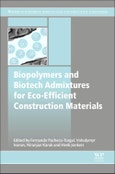Since 1930 more than 100,000 new chemical compounds have been developed and insufficient information exists on the health assessment of 95 percent of these chemicals in which a relevant percentage are used in construction products. For instance Portland cement concrete, the most used material on the Planet (10.000 million tons/year that in the next 40 years will increase around 100 %) currently used in around 15% of total concrete production contains chemicals used to modify their properties, either in the fresh or hardened state.
Biopolymers are materials that are developed from natural resources. They reduce dependence on fossil fuels and reduce carbon dioxide emissions. There is a worldwide demand to replace petroleum-based materials with renewable resources.
Currently bio-admixtures represent just a small fraction of the chemical admixtures market (around 20%) but with environmental awareness for constituents in construction materials generally growing (the Construction Products Regulation is being enforced in Europe since 2013), the trend towards bio-admixtures is expected to continue.
This book provides an updated state-of-the-art review on biopolymers and their influence and use as admixtures in the development of eco-efficient construction materials.
Please Note: This is an On Demand product, delivery may take up to 11 working days after payment has been received.
Table of Contents
1. Introduction to biopolymers and biotech admixtures for eco-efficient construction materials
Section One. Production of biopolymers for eco-efficient construction materials
2. Basic concepts on biopolymers and biotechnological admixtures for eco-efficient construction materials
3. Biotechnological production of biopolymers and admixtures for eco-efficient construction materials
4. Life cycle assessment of biopolymers
Section Two. Biopolymers and biotech admixtures in cement and mortars
5. Biotech admixtures for enhancing portland cement hydration
6. Black liquor waste as a cement admixture or cement and concrete admixtures
7. High-performance superplasticizer based on chitosan
8. Microorganism-based bioplasticizer for cementitious materials
9. Fly ash-based geopolymer with kappa-carrageenan biopolymer
Section Three. Biopolymers and biotech admixtures in concrete
10. Biopolymers with superplasticizer properties for concrete
11. Biopolymers with viscosity-enhancing properties for concrete
12. Biotech solutions for concrete repair with enhanced durability
Section Four. Other biopolymer applications
13. Rigid biofoam composites as eco-efficient construction materials
14. Biopolymers for wood preservation
15. Biopolymers for paints and surface coatings
16. Bio-based adhesives
17. Biopolymers as biofilters and biobarriers
18. Biopolymers for superhydrophobic photocatalytic coatings








